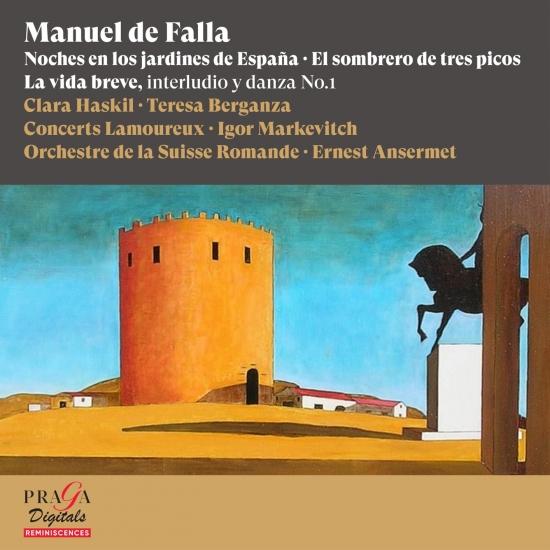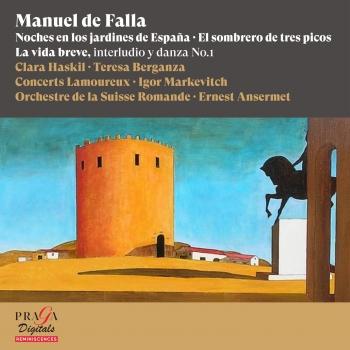
Manuel de Falla: Noches en los jardines de España, El sombrero de tres picos & La vida breve (interludio y danza No. 1) (Remastered) Clara Haskil, Teresa Berganza, Igor Markevitch, Ernest Ansermet
Album info
Album-Release:
2021
HRA-Release:
17.11.2021
Label: Praga Digitals
Genre: Classical
Subgenre: Vocal
Artist: Clara Haskil, Teresa Berganza, Igor Markevitch, Ernest Ansermet
Composer: Manuel de Falla (1876-1946)
Album including Album cover Booklet (PDF)
- Manuel de Falla (1876 - 1946): Noches en los jardines de España, for piano and orchestra:
- 1Falla: Noches en los jardines de España, for piano and orchestra: I. En el Generalife10:00
- 2Falla: Noches en los jardines de España, for piano and orchestra: II. Danza lejana04:34
- 3Falla: Noches en los jardines de España, for piano and orchestra: III. En los jardines de la Sierra de Córdoba07:55
- La Vida breve:
- 4Falla: La Vida breve: Interludio y danza, No. 107:13
- El Sombrero de tres picos:
- 5Falla: El Sombrero de tres picos: I. Introducción01:35
- 6Falla: El Sombrero de tres picos, Part I: II. La tarde05:05
- 7Falla: El Sombrero de tres picos, Part I: III. Danza de la molinera03:38
- 8Falla: El Sombrero de tres picos, Part I: IV. Las uvas04:08
- 9Falla: El Sombrero de tres picos, Part II: V. Danza de los vecinos03:14
- 10Falla: El Sombrero de tres picos, Part II: VI. Danza del molinero06:59
- 11Falla: El Sombrero de tres picos, Part II: VII. Danza del corregidor06:01
- 12Falla: El Sombrero de tres picos, Part II: VIII. Danza final06:12
Info for Manuel de Falla: Noches en los jardines de España, El sombrero de tres picos & La vida breve (interludio y danza No. 1) (Remastered)
An anthology from Manuel de Falla’s masterpieces, in which he invented modern Spanish music and he revived authentic songs, rhythms and dances out of an Andalusia both legendary and still alive. Tribute to performers, while awaiting for their centenaries, such as Clara Haskil, Igor Markevitch or Ernest Ansermet, who made immortal these pieces or taught their requirements and specificities to artists such as Teresa Berganza…Incunabula!
Clara Haskil, piano
Teresa Berganza, mezzo-soprano
Igor Markevitch, conductor
Lamoureux Orchestra
Ernest Ansermet, conductor
Digitally remastered
Clara Haskil
(7 January 1895 - 7 December 1960) was a Jewish Romanian classical pianist, renowned as an interpreter of the classical and early romantic repertoire.
Haskil was particularly noted for her performances and recordings of Mozart. Many considered her the foremost interpreter of Mozart in her time. She was also noted as a superb interpreter of Beethoven, Schumann, and Scarlatti.
Haskil was born into a Sephardic Jewish family in Bucharest, Romania and studied in Vienna under Richard Robert (whose memorable pupils also included Rudolf Serkin and George Szell) and briefly with Ferruccio Busoni. She later moved to Paris, where she started studying with Gabriel Fauré's pupil Joseph Morpain, whom she always credited as one of her greatest influences. The same year she entered the Paris Conservatoire, officially to study with Alfred Cortot although most of her instruction came from Lazare Lévy and Mme Giraud-Letarse, and graduated at age 15 with a Premier Prix. She also graduated with a Premier Prix in violin. Upon graduating, Haskil began to tour Europe, though her career was cut short by one of the numerous physical ailments she suffered throughout her life. In 1913 she was fitted with a plaster cast in an attempt to halt the progression of scoliosis. Frequent illnesses, combined with extreme stage fright that appeared in 1920, kept her from critical or financial success. Most of her life was spent in abject poverty. It was not until after World War II, during a series of concerts in the Netherlands in 1949, that she began to win acclaim.
As a pianist, her playing was marked by a purity of tone and phrasing that may have come from her skill as a violinist. Transparency and sensitive inspiration were other hallmarks of her style.
Well regarded as a chamber musician, Haskil collaborated with such famed musicians as George Enescu, Eugène Ysaÿe, Pablo Casals, Joseph Szigeti, Géza Anda, Isaac Stern and Arthur Grumiaux, with whom she played her last concert. While renowned primarily as a violinist, Grumiaux was also a fine pianist, and he and Haskil would sometimes swap instruments.
She played as a soloist under the baton of such conductors as Ansermet, Barbirolli, Beecham, Boult, Celibidache, Cluytens, Fricsay, Giulini, Inghelbrecht, Jochum, Karajan, Kempe, Klemperer, Kubelik, Markevitch, Monteux, Münch, Paray, Rosbaud, Sawallisch, Solti, Stokowski, Szell, among many others.
Haskil died from injuries received through a fall at a Brussels train station. She was to play a concert with Arthur Grumiaux the following day.
An esteemed friend of Haskil, Charles Chaplin, described her talent by saying "In my lifetime I have met three geniuses; Professor Einstein, Winston Churchill, and Clara Haskil. I am not a trained musician but I can only say that her touch was exquisite, her expression wonderful, and her technique extraordinary." (Swiss Radio interview, 19 April 1961.)











